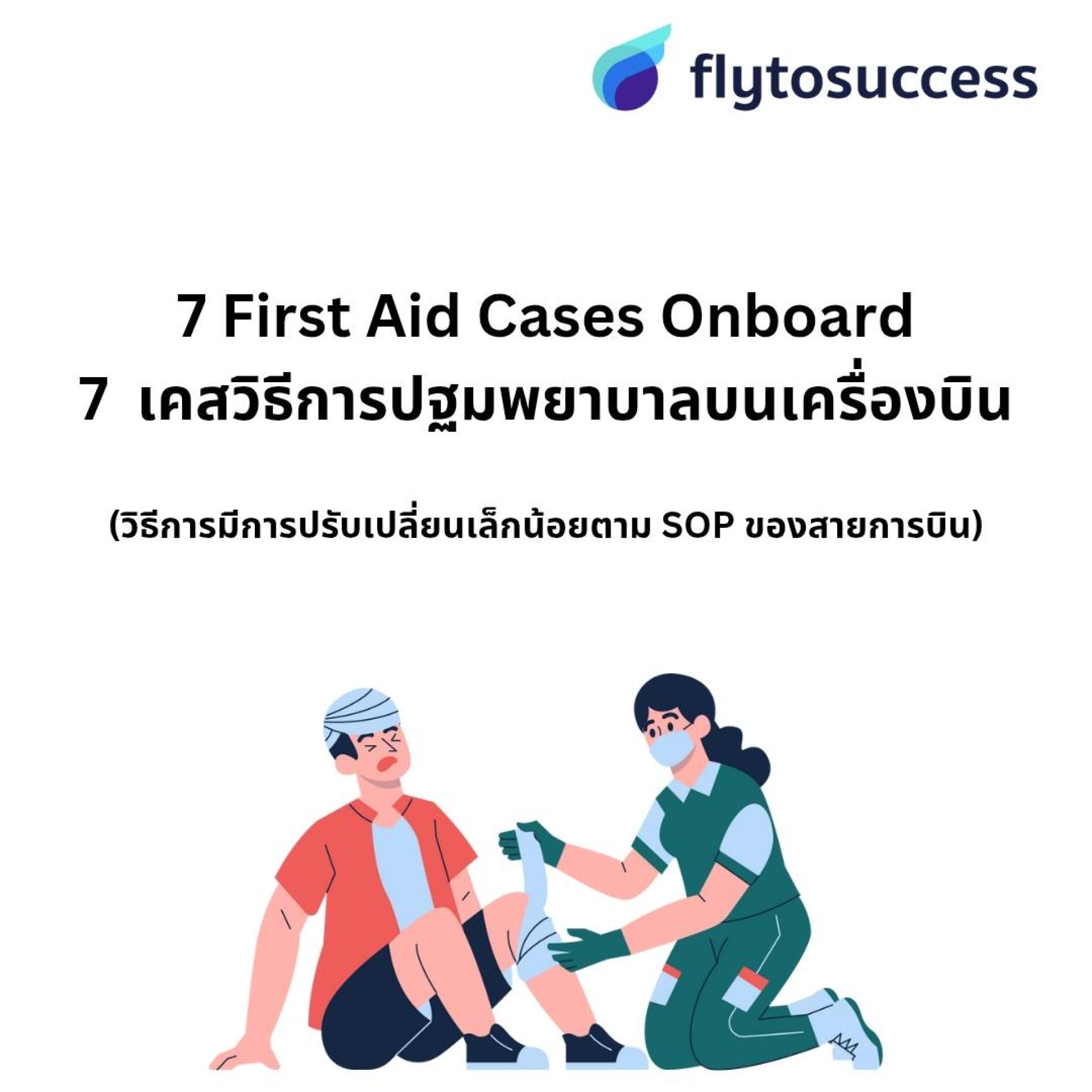7 เคสวิธีการปฐมพยาบาลบนเครื่องบิน

7 First Aid Cases Onboard
7 เคสวิธีการปฐมพยาบาลบนเครื่องบิน
.
(วิธีการอาจมีการปรับเปลี่ยนเล็กน้อยตาม SOP ของสายการบิน)
1. Choking (สำลักอาหาร)
What to do:
Encourage the passenger to cough forcefully if they can still breathe or talk.
If they cannot breathe, perform the Heimlich maneuver (abdominal thrusts).
If the passenger becomes unconscious, start CPR immediately and use an AED if necessary.
(ทำอย่างไร)
กระตุ้นให้ไอแรง ๆ ถ้ายังหายใจหรือพูดได้
ถ้าหายใจไม่ออก ให้ใช้ Heimlich Maneuver (กดท้องใต้ลิ้นปี่)
ถ้าหมดสติ ให้ทำ CPR ทันที และใช้ AED หากจำเป็น
2. Severe Allergic Reaction (Anaphylaxis) (อาการแพ้รุนแรง)
What to do:
Ask if the passenger has an EpiPen and assist them in using it.
Provide oxygen if needed.
Notify the captain and seek medical assistance immediately.
(ทำอย่างไร)
ถามว่าผู้โดยสารมี EpiPen หรือไม่ และช่วยเหลือในการใช้
ให้ออกซิเจนหากจำเป็น
แจ้งกัปตันและขอความช่วยเหลือทางการแพทย์ทันที
3. Sprain (เคล็ด ข้อเท้าพลิก) Use RICE Method
What to do (RICE Method):
Rest: Have the passenger rest and avoid moving the injured area.
Ice: Apply an ice pack (wrapped in cloth) for 15-20 minutes.
Compression: Wrap the injured area with a bandage to reduce swelling.
Elevation: Raise the injured limb above heart level if possible.
(ทำอย่างไร - หลัก RICE)
Rest (พัก): ให้ผู้โดยสารหยุดใช้งานบริเวณที่บาดเจ็บ
Ice (ประคบเย็น): ใช้ถุงน้ำแข็งห่อผ้าประคบ 15-20 นาที
Compression (พันผ้ายืด): ใช้ผ้ายืดพันเพื่อลดอาการบวม
Elevation (ยกสูง): ยกบริเวณที่บาดเจ็บให้อยู่สูงกว่าระดับหัวใจ
4. Fainting (เป็นลม)
What to do:
Lay the passenger flat on their back with legs elevated.
Loosen tight clothing and ensure they have fresh air.
Offer water once they regain consciousness.
If they do not wake up within a minute, check for breathing and pulse, and prepare for CPR if needed.
(ทำอย่างไร)
ให้ผู้โดยสาร นอนราบและยกขาสูง
คลายเสื้อผ้าให้หายใจสะดวก
ให้ดื่มน้ำเมื่อตื่นขึ้นมาแล้ว
ถ้าไม่ฟื้นใน 1 นาที ตรวจชีพจรและการหายใจ พร้อมเตรียมทำ CPR หากจำเป็น
5. Nosebleed (เลือดกำเดาไหล)
What to do:
Have the passenger lean forward slightly, not tilt their head back.
Pinch the soft part of the nose for 10-15 minutes.
Apply a cold compress on the bridge of the nose.
If bleeding continues for over 20 minutes, seek medical assistance.
(ทำอย่างไร)
ให้ผู้โดยสาร ก้มหน้าลงเล็กน้อย ห้ามเงยหน้า
บีบที่ปีกจมูกค้างไว้ 10-15 นาที
ประคบเย็นบริเวณดั้งจมูก
ถ้าเลือดไม่หยุดไหลเกิน 20 นาที ให้ขอความช่วยเหลือทางการแพทย์
6. Hyperventilation (หายใจเร็วผิดปกติจากความเครียด/ตื่นตระหนก)
What to do:
Calm the passenger and encourage slow, deep breathing.
Have them breathe into a paper bag or cup their hands over their mouth.
Reassure them and avoid sudden movements.
If symptoms persist, provide oxygen and monitor for further issues.
(ทำอย่างไร)
ปลอบให้ผู้โดยสาร หายใจช้าและลึก
อาจให้หายใจใส่ถุงกระดาษหรือใช้มือครอบปาก
คอยพูดให้กำลังใจและไม่ให้ตื่นตระหนก
หากอาการไม่ดีขึ้น อาจให้ออกซิเจนและติดตามอาการ
7. Burns (แผลน้ำร้อนลวก/ไฟไหม้ผิวหนัง)
What to do:
Rinse the burned area with cool water for 10-20 minutes (do not use ice).
Cover the burn with a sterile, non-stick dressing.
Do not apply lotions, butter, or oils.
If severe, seek immediate medical attention.
(ทำอย่างไร)
ล้างแผลด้วย น้ำสะอาดที่อุณหภูมิปกติ 10-20 นาที (ห้ามใช้น้ำแข็ง)
ปิดแผลด้วย ผ้าพันแผลปลอดเชื้อที่ไม่ติดแผล
ห้ามทายา โลชั่น หรือเนย
ถ้าเป็นแผลรุนแรง ให้รีบขอความช่วยเหลือทางการแพทย์
Key Takeaway
ลูกเรือต้อง ตั้งสติ ประเมินอาการ และแจ้งกัปตัน
ใช้ First Aid Kit และอุปกรณ์บนเครื่องบิน ตามมาตรฐานของสายการบิน
เฝ้าระวังอาการ และเตรียมพร้อมสำหรับ CPR และ AED เมื่อจำเป็น


